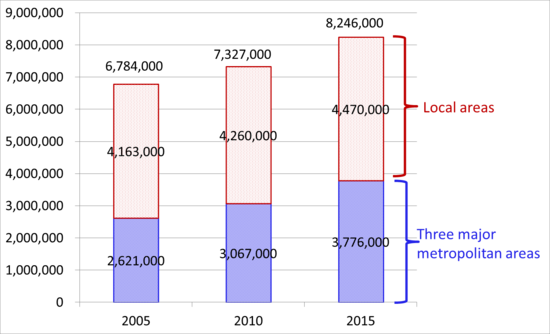Column Finance and the Social Security System 2019.04.18
【Aging, safety net and fiscal crisis in Japan】No.177: Shopping refugees are increasing in major metropolitan areas
The Ministry of Agriculture, Forestry, and Fisheries has released a population estimate of shopping refugees every five years. Shopping refugees are people who meet the following three conditions and have difficulty accessing food products.
[ Three conditions of a shopping refugee ]
- 1. 65 years or older
- 3. He or she cannot drive a car
As shown in Figure 1, the number of shopping refugees increased 21.6% from 6,784,000 in 2005 to 8,246,000 in 2015. It should be noted that the growth rate (2,621,000➡3,776,000: + 44.1%) in the three major metropolitan areas is greater than that (4,163,000➡4,470,000: + 7.4%) of the local areas. The three major metropolitan areas are Tokyo, Nagoya, and Osaka (Figure 2). For example, Tokyo area includes the 4 prefectures of Tokyo, Saitama, Chiba, and Kanagawa.
Table 1 shows the number of shopping refugees in 2015 by region and age group. A total of 33.1% of elderly individuals aged 75 or older are shopping refugees. In addition, the number of shopping refugees in Tokyo area has already exceeded 1 million. This reflects a rapid increase in the elderly population in Tokyo area.
Figure1. The number of shopping refugees
 Source: Ministry of Agriculture, Forestry, and Fisheries
Source: Ministry of Agriculture, Forestry, and FisheriesFigure 2. Location of three major metropolitan areas

Table 1. Details of shopping refugees as of 2015

Source: Ministry of Agriculture, Forestry, and Fisheries
